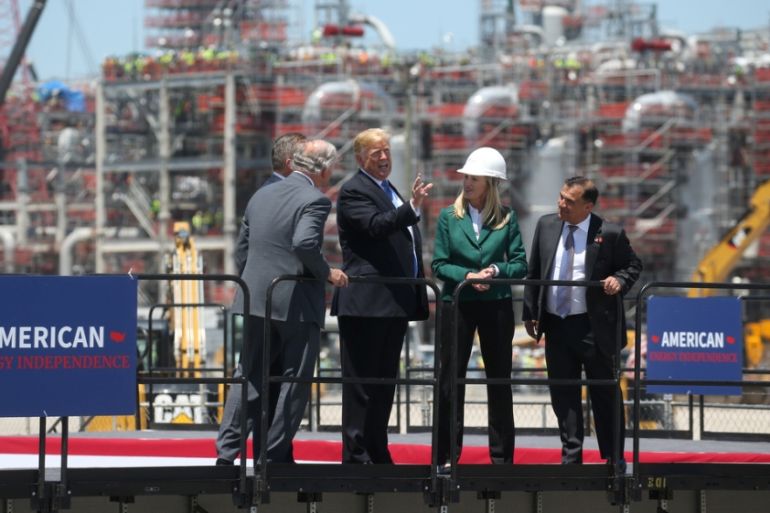Risky business: The allure of liquefied natural gas
Energy companies have big plans for more export terminals in North America, but a new report calls them into question.

Around the world, energy firms are investing $1.3 trillion in new terminals to transport liquefied natural gas (LNG) – mostly for fuel extracted in North America and sold to buyers in East Asia, according to a new report released on Monday by Global Energy Monitor.
Companies hoping to capitalise on the global gas boom by massively increasing LNG export and import infrastructure could be gambling on the future of the industry. They risk creating “stranded assets” – what the report describes as equipment, machinery and facilities that may one day lie in waste after an initial period of profitability.
Keep reading
list of 4 itemsWhat’s slowing down America’s clean energy transition? It’s not the cost
Global coal use to reach record high in 2023, energy agency says
COP28 Dubai is over: Four key highlights from the UN climate summit
Due to a combination of low natural gas prices, the decreasing price of renewable forms of energy that are in competition with fossil fuels, and the anticipated future regulatory costs of greenhouse gas emissions, the long-term infrastructure outlays may not make financial sense, the report said.
“Everybody knows there’s been a fracking boom for the last decade, so the investments in fracking are [typical of] extraction: you drill and, well, and you take your chances,” said Ted Nace, co-author of the report and executive director of Global Energy Monitor. “Investing in infrastructure is a different animal, in that you’re making 40-year investments. These are questionable.”
“This is a lot of resources to sink into something that may be at the end of its life cycle, in terms of how the economy will transition,” Nace told Al Jazeera.
His organisation, where the research goal is to highlight clean-energy alternatives, produces the Global Fossil Infrastructure Tracker to map projects currently under development.
LNG, while representing barely five percent of all natural gas in 2000, now comprises 11 percent – reflecting advances in the technology required to liquefy gas for export and then re-gasify it for import. If completely implemented, the proposals on hand will mean 20 percent of all gas production will be LNG by 2030.
Historically, the vast majority of natural gas stayed in the same forms, being extracted, then transported in pipelines to nearby regions, and finally burned for electricity generation or other purposes.
But due to soaring demands for power, heating and cooling – for consumers who are thousands of miles from the source – the process of drilling, converting to LNG, and shipping to overseas purchasers is enormously lucrative at present.
However, the price tag for terminals under development might lock economies into a part of the energy sector that will become increasingly unpredictable decades down the road, given advances in green energy.
Twenty-five percent of global warming impacts are caused by methane, which is the biggest component of natural gas.
There are 116 export terminals and 86 import terminals currently in development.
LNG export terminals are under way in 20 countries, of which Canada and the United States account for 74 percent of proposed new capacity, the report said. If built, LNG terminals in pre-construction and construction would increase current global export capacity threefold.
An addendum to the report showed that the three firms planning to invest the most money in new terminal capacity are NextDecade ($44bn), ExxonMobil ($39bn) and Freeport-McMoRan Inc ($37bn).
“This report runs counter to documentation of the positive role that natural gas and LNG can play in the global energy transition,” said a statement provided to Al Jazeera by the Center for Liquefied Natural Gas. “The US LNG industry is carefully responding to the long-term needs of the global LNG market and investing in cutting-edge facilities to meet growing demand, particularly in Asia and Europe.”
“LNG also is the ideal operational partner for renewables as it can provide reliable baseload power when the sun is not shining and wind is not blowing,” said the statement.
“Globally, LNG is playing a role in reducing emissions and air pollution of nations looking to relieve energy poverty,” it added.
Many of the proposed terminals would export gas coming from the Permian Basin in western Texas via the Gulf of Mexico coast.
At present, the biggest LNG exporters are Qatar, Australia, and Malaysia, while the biggest importers are Japan, China, and South Korea. So the planned new terminals are aimed at seizing a much greater market share for North American suppliers.
“Overcapacity doesn’t serve the industry well,” said Nace. “It leads to fire sales … too many sellers, and not enough buyers.”
“The supporting players need to look at this, especially investors,” Nace said. Referring to the decline in coal stocks that in recent years hit pension funds and universities, he noted, “We’re saying the same thing with this [LNG expansion]”.
“If putting together an energy fund, this is not where I’d put my money,” he added.
The report said that only eight percent of terminal capacity currently under development has moved beyond the final investment decision stage into actual construction, so there may still be a way to avoid overbuilding new terminals.